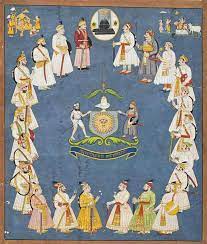In our previous article, we had covered the story of Rana Hammir Singh who took back Chittorgarh from the influence of the Delhi Sultanate.
Yet Mewar didn’t back down and fought audaciously for its independence. Rana Kshetra the son of Rana Hammir Singh maintained the centuries-old pride and valor of Mewari Rajputs and protected the kingdom from the onslaughts of sultanates.
But still, the position of Mewar was far from secure the neighboring sultanates always threatened their borders and the threat of the ever-powerful sultanate of Delhi made the independence of Mewar vulnerable.
Content
Rise of Rana Kshetra
Rana Kshetrasimha ascended the throne of Mewar after his father’s demise. Historians claim that he had ruled for more than 25 years.

(Some historians also suggest the reign of Rana Kshetra from 1378-to 1405). As mentioned by R.C.Majumdar the chronology period of the Rajputs from 1303 to 1420 is extremely difficult to follow.

His father i.e. Rana Hammir disintegrated all the invasions of neighboring sultanates into pieces but the conditions of Mewar were still precarious. But under Rana Kshetrasimha’s visionary leadership the kingdom of Mewar regained its strength.
He not only protected the kingdom of Mewar but also followed the path of expansionist policy. During his reign, the boundaries of Mewar were increased in all directions.
He also started the reconstruction of the fort which had suffered from the devastation of many invaders.
Note: Colonel James Todd had mentioned that Rana Hammir was a great Hindu ruler of his time.
Military Campaign and Conquests
During the reign of Rana Kshetra, the situation of Delhi was in ruins. The weak successor which came after Firoz Shah couldn’t maintain their hegemony over other states. Later the invasion by Timur in 1398 completely crushed the power of the Delhi Sultanate.
Due to these incidents, Mewar got enough time to expand its boundaries and Rana Kshetra didn’t hesitate to follow this path.
Rana Kshetra’s first military campaign was against the fellow Hada Rajputs of Bundi. Rana Kshetra wanted to establish control of Mewar over Bundi. Due to the rising prowess of Rana Kshetra, the war between these two Rajput clans became inevitable.
Mewar defeated the Rajputs of Bundi and also destroyed the fort of Mandalgadh. Due to this victory, Rana Kshetra became the first king of Mewar to defeat the Hada Rajputs of Bundi.
Next, the king of Mewar marched against the sultan of Malwa. At this time the ruler of Malwa was Dilavar Khan Ghuri also known as Ami Shah. According to Menal inscription of 1389 CE, a battle was fought between these two in which the Mewar army defeated the army of the Sultan.
In this battle Mahadeva, the Hada chieftain of Bundi played a major part in this battle.
Later according to Firishta Rana Kshetra again crossed swords with Dilavar Khan. Many historians claimed that the battle resulted in the victory of Mewar and Rana Kshetra ended this struggle once and for all.
The struggle between Mewar and Malwa continued for many years. From the reign of Rana Kshetra to Rana Sanga the struggle between these two remained.
Note: It is believed that Rana Kshetra died in a campaign against the Hada Rajputs of Bundi.
Note: During his reign, Rana Kshetra also captured the region of Ajmer, Bhilwara, and Chappan. Other sources mentioned that Rana Kshetra also conquered the territory of Hadoti.
Rana Kshetra died in the year 1405 CE. After him, his eldest son i.e. Lakshasimha aka Lakha succeeded the throne of Mewar.
All in all Rana Kshetra was an astute leader who was capable enough to secure the independence of Mewar. Later his successors like Rana Kumbha and Rana Sanga took Mewar to new heights and expanded the kingdom in all possible directions.
Donate to our Cause
If you support what we are doing and would like to contribute to help us grow and reach more Indians to teach them more about such forgotten historic Indian Heroes and stories, please consider donating any amount. It will help us grow

